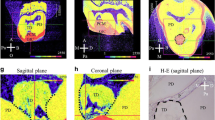Abstract
To analyse DNA strand breaks by terminal deoxy(d)-UTP nick-end labelling (TUNEL) in calcified tissues including bones and teeth, it is important to decalcify the tissues first. However, the effects of decalcifying reagents on the integrity of DNA are largely unknown. In the present study, we evaluated the usefulness of various decalcifying reagents including 10% EDTA (pH 7.4), 5% trichloroacetic acid (TCA), 5% formic acid, 5% HCl, 10% nitric acid, Plank–Rychlo's solution, Morse's solution and K-CX solution in TUNEL staining. Mouse maxilla was selected as the experimental system. Apoptotic cells naturally occurring in the epithelium were analysed. Tissues were assessed by soft X-ray imaging to confirm complete decalcification. The time required for decalcification of the tissue was 7 days with 10% EDTA and 2 days with other decalcifiers. Decalcified tissues were stained with Methyl/Green–Pyronine Y or 4′, 6-diamidino-2-phenylindole for assessment of DNA integrity. Nuclei of epithelial cells were strongly positive for both dyes after decalcification with 10% EDTA, 5% TCA, Morse's solution and 5% formic acid. The other reagents failed to retain DNA. Our results demonstrated good TUNEL staining of the maxilla treated with 10% EDTA or 5% TCA . Based on the required time for processing and the signal-noise ratio, we recommend 5% TCA as the decalcifying reagent to analyse for DNA strand breaks.
Similar content being viewed by others
References
Alers JC, Krijtenburg PJ, Vissers KJ, van Dekken H (1999) Effect of bone decalcification procedures on DNA in situ hybridization and comparative genomic hybridization. EDTA is highly preferable to a routinely used acid decalcifier. J Histochem Cytochem 47: 703-710.
Arber JM, Arber DA, Jenkins KA, Battifora H (1996) Effect of decalcification and fixation in paraffin-section immunohistochemistry. Appl Immunohistochem 4: 241-248.
Arber JM, Weiss LM, Chang KL, Battifora H, Arber DA (1997) The effect of decalcification on in situ hybridization. Mod Pathol 10: 1009-1014.
Banks PM (1979) Diagnostic applications of an immunoperoxidase method in hematopathology. J Histochem Cytochem 27: 1192-1194.
Bianco P, Silvestrini G, Termine JD, Bonucci E (1988) Immunohistochemical localization of osteonectin in developing human and calf bone using monoclonal antibodies. Calcif Tissue Int 43: 155-161.
Frank JD, Balena R, Masarachia P, Seedor JG, Cartwright ME (1993) The effects of three different demineralization agents on osteopontin localization in adult rat bone using immunohistochemistry. Histochemistry 99: 295-301.
Gavrieli Y, Sherman Y, Ben-Sasson SA (1992) Identification of programmed cell death in situ via specific labeling of nuclear DNA fragmentation. J Cell Biol 119: 493-501.
Graner E, Line SR, Almeida OP, Lopes MA (1995) Use of TCA as a decalcifying agent for laminin immunohistochemistry. Calcif Tissue Int 57: 306.
Hakuno N, Koji T, Yano T, Kobayashi N, Tsutsumi O, Takatani Y, Nakane PK (1996) Fas/APO-1/CD95 system as a mediator of granulosa cell apoptosis in ovarian follicle atresia. Endocrinology 137: 1938-1948.
Hashimoto S, Koji T, Niu J, Kanematsu T, Nakane PK (1995) Differential staining of DNA strand breaks in dying cells by non-radioactive in situ nick translation. Arch Histol Cytol 58: 161-170.
Ito Y, Otsuki Y (1998) Localization of apoptotic cells in the human epidermis by an in situ DNA nick end-labeling method using confocal reflectant laser microscopy. J Histochem Cytochem 46: 783-786.
Kaneko H, Ogiuchi H, Shimono M (1997) Cell death during tooth eruption in the rat: surrounding tissues of the crown. Anat Embryol (Berl) 195: 427-434.
Kieman JA (1981) Histological and Histochemical Methods: Theory and Practice. Oxford: Pergamon Press, pp. 8-28.
Koji T (1996) Nonradioactive in situ nick translation: a useful molecular histochemical tool to detect single-stranded DNA breaks. Acta Histochem Cytochem 29: 71-79.
Lee GL (1968) Manual of Histologic Staining Methods of the Armed Forces Institute of Pathology, 3rd edn. McGraw-Hill Book Company, pp. 8-9.
Morse M (1945) Formic acid-sodium citrate decalcification and butyl alcohol dehydration of teeth and bones for sectioning in paraffin. J Dent Res 24: 143-153.
Mullink H, Henzen-Logmans SC, Tadema TM, Mol JJ, Meijer CJLM (1985) Influence of fixation and decalcification on the immunohistochemical staining of cell-specific markers in paraffin-embedded human bone biopsies. J Histochem Cytochem 33: 1103-1109.
Plank VJ, Rychlo A (1952) Eine Schnellentkalkungsmethode. Zbl Pathol 89: 252-254.
Sakai T, Kiyoshima T, Kobayashi I, Moroi R, Ibuki T, Nagadome M, Terada Y, Sakai H (1999) Age-dependent changes in the distribution of BrdU-and TUNEL-positive cells in the murine gingival tissue. J Periodontol 70: 973-981.
Schulte EK, Lyon HO, Hoyer PE (1992) Simultaneous quantification of DNA and RNA in tissue sections: a comparative analysis of the methyl green-pyronine technique with gallocyanin chromalum and Feulgen procedures using image cytometry. Histochem J 24: 305-310.
Shibata Y, Fujita S, Takahashi H, Yamaguchi A, Koji T (2000) Assessment of decalcifying protocols for detection of specific RNA by nonradioactive in situ hybridization in calcified tissues. Histochem Cell Biol 113: 153-159.
Stevens A, Lowe J, Bancroft JD (1990) Bone. In: Steven A, Bancroft JD, eds. Theory and Practice of Histological Techniques, 3rd edn. Edinburgh: Churchill Livingstone, pp. 309-341.
Takata K, Hirano H (1990) Use of fluorescein-phalloidin and DAPI as a counterstain for immunofluorescence microscopic studies with semithin frozen sections. Acta Histochem Cytochem 23: 679-683.
Walsh L, Freemont AJ, Hoyland JA (1993) The effect of tissue decalcification on mRNA retention within bone for in-situ hybridization studies. Int J Exp Pathol 74: 237-241.
Wang RA, Nakane PK, Koji T (1998) Autonomous cell death of mouse male germ cells during fetal and postnatal period. Biol Reprod 58: 1250-1256.
Yoshii A, Koji T, Ohsawa N, Nakane PK (1995) In situ localization of ribosomal RNAs is a reliable reference for hybridizable RNA in tissue sections. J Histochem Cytochem 43: 321-327.
Author information
Authors and Affiliations
Rights and permissions
About this article
Cite this article
Yamamoto-Fukuda, T., Shibata, Y., Hishikawa, Y. et al. Effects of Various Decalcification Protocols on Detection of DNA Strand Breaks by Terminal DUTP Nick End Labelling. Histochem J 32, 697–702 (2000). https://doi.org/10.1023/A:1004171517639
Issue Date:
DOI: https://doi.org/10.1023/A:1004171517639




